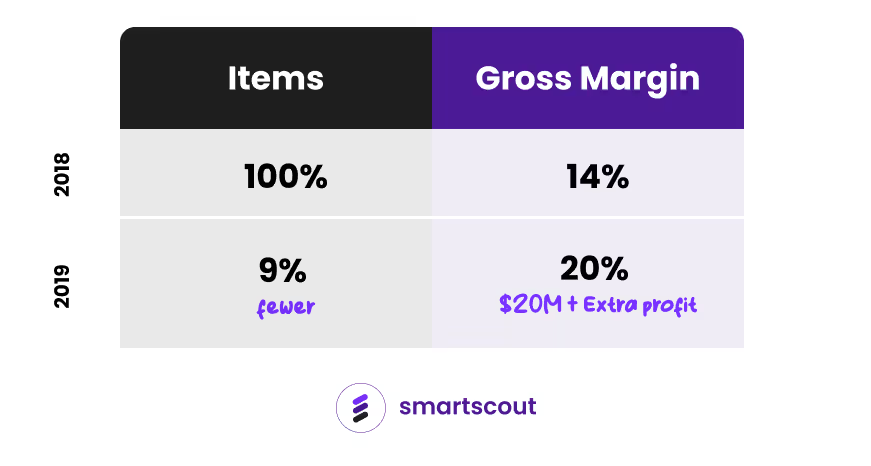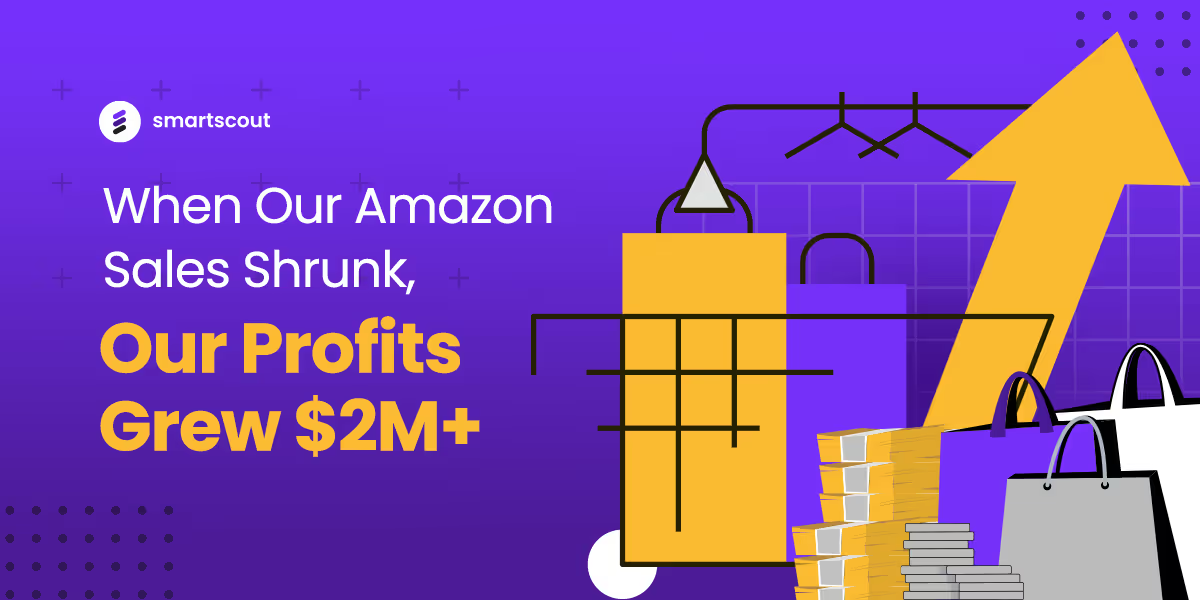Most people believe that more sales always mean more profits. My experience with Amazon proved otherwise.
Since 2013, I’ve been experimenting with ways to win the Buy Box and boost our profits. I tried benchmarking our prices against competitors. I tried creating software to predict competitor stockouts. I even aimed for a perfect feedback rating. Yet, none of these strategies made a huge impact on our business.
Until we had a breakthrough moment.
In 2018, we achieved 65 million in sales at a 14% gross margin. The following year, we sold 9% fewer items. Our sales shrunk, but we made 2 million dollars in extra profits.

This revelation was a surprise, not just for me but for our entire team at BuyBoxer. Since then, I stopped focusing on the many unpredictable factors tied to winning the BuyBox and started focusing on the ONE thing we had complete control: Price.
Stop looking at your competitor’s pricing. Let your sales dictate your price.
In the past, when I tried to benchmark our prices against competitors or predict their stockouts, I missed the mark. The game-changer was when we began concentrating solely on our own sales metrics.
Are we selling? Great. Maybe we can price up.
Oh, we’re not selling? Maybe we could price down.
You can spend all your time building fancy tools to look at your competition, but your sales data remains the number one indicator of how much you should price.
Increase Profits With These 8 Pricing Strategies We Use at BuyBoxer
The strategies outlined below are ways to bolster your profits without necessarily increasing sales volume.
Strategy #1 Sell High for the First Few Days
Contrary to popular belief, the goal isn't always to undercut competitors. Instead, find every possible reason to elevate prices.
By increasing our prices three times a day for short 30-minute intervals, we subtly nudge competitors to follow suit, especially when there are only two or three main competitors. This strategy is rooted in the idea that a rising tide lifts all boats. If every seller understood the power of this approach, the marketplace would see a shift from a race to the bottom to a collective rise in profitability.
During the initial days of listing a product, we maintain a firm stance. We price at 20% or more gross margin, with 20% being our non-negotiable minimum. If a product garners sales traction in the subsequent days, we let it be. But if it lags, we strategically adjust our floor price at regular intervals—three days, eight days, or 15 days.
Strategy #2 Ladder Pricing
This strategy works on the tail-end of your inventory. If you’re going to stock out, sell every single product higher than the last.

There's a segment of shoppers who are willing to pay more. In the final two weeks of our inventory cycle, we're especially responsive. If we've made a sale in the past 24 hours, and the momentum continues, we nudge the price upwards. If we’re not making sales, we make a slight downward adjustment. This strategy particularly shines with seasonal products and when competitors are also nearing stockouts.
Strategy #3 Day-Night YoYo Pricing
Our Day-Night YoYo strategy involves a simple yet effective tweak: we increase prices a dollar or two during nighttime hours. As day breaks, we revert to our standard pricing, only to elevate it again as night approaches.
This pricing change might seem minor, but it brings a huge cumulative impact. With this strategy, even an extra dollar on each sale can have a significant impact. Over a million items sold annually, that's a potential additional revenue of $1 million.

Strategy #4 Split-Minute YoYo Pricing
This strategy works with very fast-selling products and against big sellers that dominate the Buy Box, including Amazon. I'm always worried that this strategy will go away, but it still works.
Throughout the day, in intervals of about 20-30 minutes, we would YoYo. We momentarily undercut the top competitor, sometimes by as little as 1 cent or as much as 20 cents, only to revert to our original price shortly after. Sometimes, it's as little as about 30 seconds. These brief windows allow us to make some sales.
Use this if your inventory is stuck against a competitor that just doesn’t give up.
Strategy #5 Never Compete Against Amazon
Just avoid Amazon retail. Don’t sell against them. Some people will disagree but, this is how we built a stable business.
You can win a few times. But you'll get burned most of the time. I've seen sellers raise tens of millions of dollars, they get a little proud, "Let's get all the inventory," and go deep against Amazon retail. Those businesses are not around anymore.
Strategy #6 Coupon Over Discount
When you've got inventory that's been sitting around for a while, the instinct might be to just drop the price. But here's something I've learned: using a coupon can be more effective. A customer sees a product priced at $20, then sees a $2 coupon available. To the customer, it feels like they've stumbled upon a special deal, even if the end price is the same.
If you've got products that have been on the shelf for over 180 days, this might be the strategy for you. It's not just about moving the product but about creating a perception of value. From my experience, a coupon, even a small one, can often have a bigger impact than a straightforward price cut.
Strategy #7 Day 90 Break-Even Pricing
The first 90 days after listing a product on Amazon are crucial. This is the period where you're in the green, where most of the positive action happens. You're not bogged down by storage fees, and you have the flexibility to price ambitiously. But as you approach the end of this period, you need to change your pricing strategy.
By the end of 90 days, start to lower your prices. Sometimes, this means going as low as your break-even point or even incurring a slight loss. You should get out before it gets really bad.
Amazon has made over 180 days not a lot of fun. You need another pricing strategy that handles this final bracket: introduce coupons, offer discounts, or even play around with dynamic pricing. Tell your repricer you're willing to take a little bit of loss because you want to avoid getting stuck paying for inventory month after month.

Strategy #8 Profits At Purchase
Profits aren't just made when you sell. They begin when you buy. It's all about forging strong relationships with suppliers and making purchasing decisions that are both informed and strategic.
Here are a few smart moves when buying inventory:
- If a product frequently goes out of stock, there's a good chance it'll happen again. That's a sign it might be worth investing in.
- Think twice when buying seasonal products. The idea of buying Christmas items, not selling them out, and then waiting an entire year to try again? It's a risk, and it's not how we've built our stable foundation.
- Specialization is power. At first, zeroing in on a specific market or category might feel like you're closing doors. But it's quite the opposite. When you start turning away from categories that don't resonate with you or don't fully grasp, you'll find that the right opportunities start knocking on your door.
I hope these pricing strategies can help your Amazon business, too.










